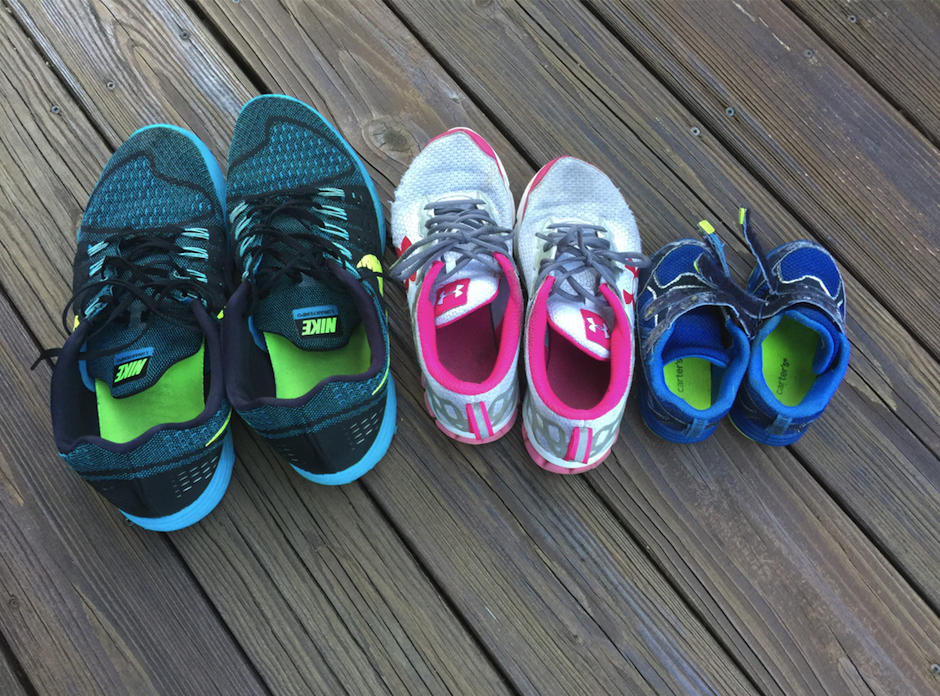By Phillip B. Sparling
I was in the basement going through our cedar chest hoping to locate some obscure document related to family history. Under the photo albums, I discovered an old baseball glove, a junior high football jersey and a pair of kangaroo-hide track spikes. Unexpectedly, I found old friends.
The Rawlings glove was dry but not disintegrating; an oiling will give it new life. The colors of the neatly folded black-and-gold jersey were barely faded. The track shoes also had aged well, a pair of Adidas, white with the trademark three black stripes and interchangeable spikes. I’d forgotten how light they were. Handling these boyhood relics triggered fond memories.
As kids growing up in Columbus, Ohio, we were continually on the move. We rode our bikes or walked to school, with side trips to climb a tree or scale a stone wall. In grade school, the popular games during recess were four-square and kickball. We’d rotate in and out. Although the most athletic dominated, everyone got to play. It was pure fun.
After school, in the fall, we’d play our rendition of tackle football in a friend’s small, but flat, backyard. No pads, helmets or hard hits. With three or four kids on a side, it was all about the excitement of running, throwing and catching a pint-size pigskin. We’d pretend to be Johnny Unitas or Jim Brown. The chief risk was a lone mulberry tree in the far left corner. The stains from the berries were the devil to get out.
On spring weekends and through the summer, we gathered in a neighborhood park, toting baseball gloves and bats. On an improvised baseball diamond in a grove of hardwoods, we played a sandlot version of the national pastime called workup, where fielders worked their way up to bat. It could be played with only eight or nine kids. No teams, no parents, no umpires.
A tempting target in center field was a city utilities building, a small brick structure with wire security screens over the windows. If a ball hit the building on the fly, it was an automatic home run. I remember the thrill of a solid hit with my ash bat, a Louisville slugger, and, watching the ball soar, wondering if it would make it. I knew what it felt like to be Mickey Mantle.
In junior high school, basketball became our main game. We’d play from fall till spring. In the winter, the P.E. teacher opened the school gym on Saturdays for pickup games. Most of the time, we’d play on driveway courts at friends’ homes. Cold weather rarely deterred us. When it snowed, we kept our favorite court shoveled. Ohio State’s Jerry Lucas and John Havlicek inspired us.
School field days were held every spring with ribbons for top placers. A few events changed from grade to grade but the broad jump, 50-yard dash and softball throw were contested every year. In the seventh grade, I discovered my knack for running long distance, finishing third in the half-mile run. The following year, I joined the track team.
In 1964, NBC made its Olympic television debut with the Summer Games in Tokyo. I watched all the coverage I could, especially track and field. A highlight was the 10,000-meter race. In a stirring final sprint, dark horse Billy Mills, an Oglala Lakota Indian and U.S. Marine, upset the field to win gold.
A decade later, opportunities for girls to experience the joy of sports finally were opening. A milestone was the passing of Title IX legislation in 1972, which mandated gender equity in college sports. The following year, women’s tennis great Billy Jean King soundly beat Bobby Riggs on national TV in the hyped Battle of the Sexes. These events ushered in a new era. At last, girls and young women were encouraged to exercise and join sports teams, just like their brothers.
Humans are wired to move and my career in academia allowed me to explore the biological and behavioral dimensions of sports and physical activity. The benefits aren’t just for the young and they’re not just about health. Being active is also about play, discovery and mastery, whether it’s shooting baskets, splitting wood or playing the piano. Enlightenment, perhaps not, but be assured, an active lifestyle enriches the human experience.
Today, primary care doctors and public health experts alike encourage us to be physically active across our lifespans. If your innate drive to be active has been dormant, rekindle it. Find the neglected sneakers in the back of the closet. How about tennis with a friend, a yoga class or simply a solitary walk? You get to choose but no prolonged pondering.
Just do it. More than a Nike slogan, it’s an inner voice cheering us on.

***
This essay is from a collection of selected newspaper columns, “The Sneakers in the Closet and Other Essays.” Topics range from play, exercise, and fitness to diet, drugs, and doctors, as well as personal reflections on growing up, finding a career and growing older. All proceeds go to the Richard Gay Israel Health and Exercise Science Scholarship at Colorado State University.
Phil Sparling is a Professor Emeritus of applied physiology at the Georgia Institute of Technology (Georgia Tech) in Atlanta, Georgia, USA. phil.sparling@gatech.edu